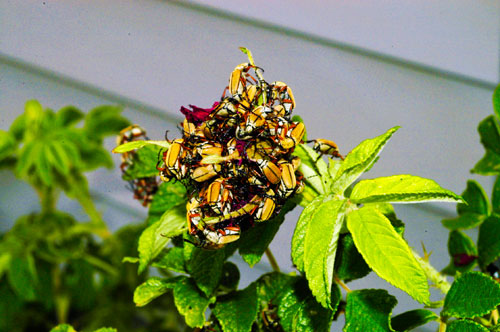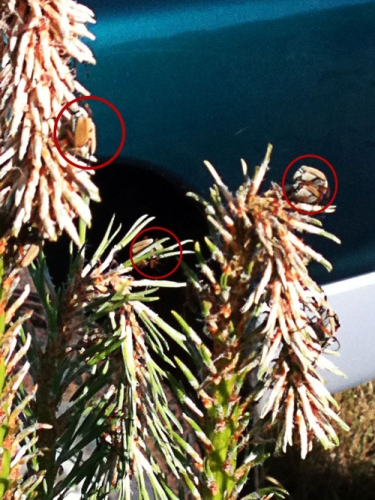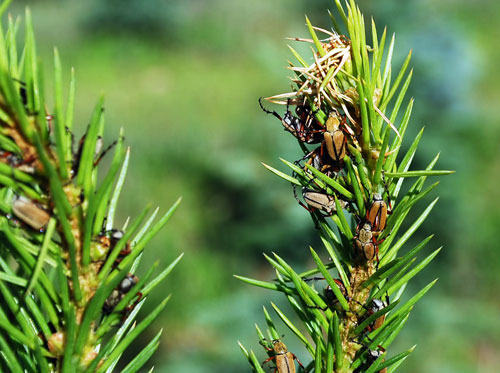When beige beetles with orange legs start to take over your garden this summer
A high population of rose chafers can do serious damage to plants in the landscape.

The rose chafer, Macrodactylus subspinosus, appears in many areas of Michigan in mid-late June. This is a native Michigan insect and a member of the same family (Scarabaeidae) as June beetles (Phyllophaga spp.) and Japanese beetles (Papillia japonica). However, the adult rose chafer looks quite different from a June beetle. Adults are about 0.05 inches long, slender, usually light tan with long, reddish-brown legs. They are also rather gangly in appearance. They are often found in mating pairs and fly during daylight hours and are not attracted to lights at night like June beetles. Adults contain a distasteful chemical; few birds can eat them without being sickened. The grub stage is typical of the entire family – a soft bodied, C-shaped white grub with six legs and a prominent brown head.
There is a single generation per year with the adults showing up in June. The activity period of adults typically lasts for only two to three weeks. Rose chafers do not always appear in significant numbers, but when they do, they are capable of causing severe damage to fruit crops and ornamental plants in Michigan.

In large numbers, rose chafers can cause significant injury to grapes, Scots pine, spruces, Fraser fir, tree fruits and many ornamental plants. Adult rose chafers feed on the foliage, buds, flowers and fruits of hundreds of plants. They have weak jaws, so they typically eat only the tenderest portions of plants. This results in a pattern of irregular holes on new needles or leaves, damage to flowers and tender stems, and sometimes broken needles.

There is some solace in the fact that the peak period of adult flight lasts only a few weeks and is done by the end of June in most of Michigan. They are good fliers and capable of traveling great distances to find a meal.
The immature (grub) stage of the rose chafer feeds on plant roots, but they are typically found only in open sandy areas where wild grasses and forbs prevail. The grubs of rose chafers are not pests of lawn grasses and landscape plants like their June beetle cousins. For information from Michigan State University Extension about managing grub damage in lawns and landscapes, visit the Gardening in Michigan website.
Adult rose chafer beetles cause minor to moderate damage in most years and are just moderately annoying. In high population years, they can be serious pests of Christmas trees, ornamental trees and fruit-bearing plants. Although it can be alarming to have feeding damage on the leaves and flowers of your plants, most mature trees and shrubs can tolerate the damage and will recover after the beetles have moved on.

If high levels are present and control methods are needed, there are several options to consider. Ornamental plants can be protected with fine mesh netting. The netting is only needed for the peak period of adult activity and can be removed thereafter. If it is not practical to net your plants, hand picking the adult beetles can be a good option. They can also be knocked off into a bucket of soapy water with a stick or brush.
In situations where insecticides are needed, extreme caution should be used to prevent harm to pollinators. Remove blossoms before applying pesticides to flowering plants and apply the product in the evening when pollinators are less active. The product label will contain additional instructions for use that will ensure you are in compliance with state and federal law. Following the label instructions will also ensure the product’s effectiveness, your safety and the safety of others. The environmental hazards section will inform you if the product is toxic to pollinators, aquatic organisms and other wildlife.
Products with the active ingredient Bacillus thuringiensis subsp. galleriae (strain SDS-502) can be used to protect plants from rose chafers with less risk of harm to bee (order Hymenoptera) and butterfly (order Lepidoptera) pollinators. This active ingredient must be consumed by insects for them to receive a lethal dose, and it only affects insects in the order Coleoptera (beetles). Sprays may have to be applied frequently to protect plants from injury as it only takes a short time for severe feeding injury to occur when the beetle population is high.



 Print
Print Email
Email


